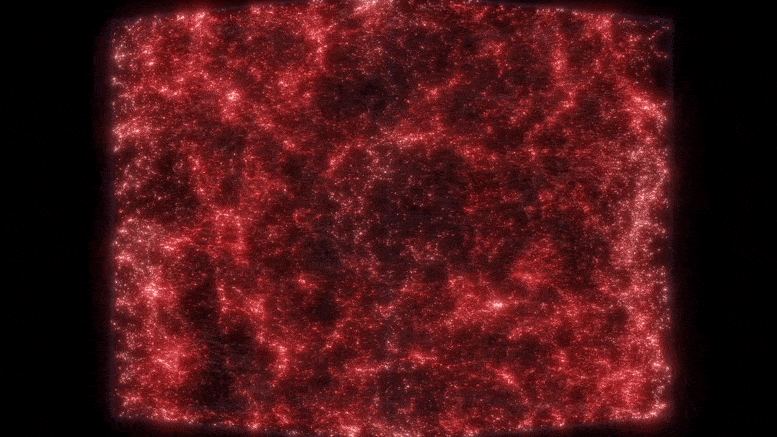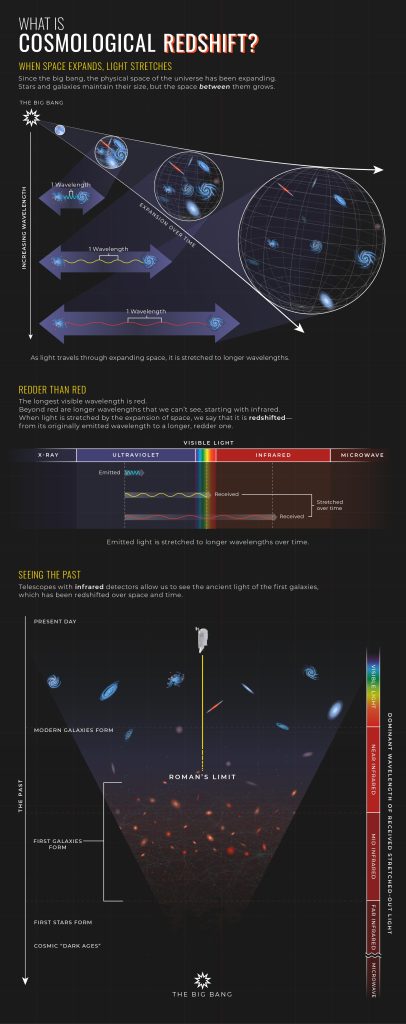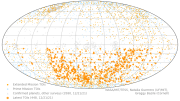
The Roman Space Telescope, set to launch by May 2027, will offer an expansive view of the universe, enabling scientists to explore cosmic mysteries in ways never before possible.
A team of scientists has predicted the science return from one of NASA’s Nancy Grace Roman Space Telescope’s groundbreaking planned surveys, which will analyze millions of galaxies strewn across space and time. The mission’s enormous, deep panoramas will provide the best opportunity yet to discern between the leading theories about what’s speeding up the universe’s expansion.
Roman will explore this mystery using multiple methods, including spectroscopy – the study of the color information in light. This technique will allow scientists to precisely measure how fast the universe expanded in different cosmic eras and trace how the universe has evolved.
This video dissolves between six cubes to show the simulated distribution of galaxies at redshifts 9, 7, 5, 3, 2, and 1, with the corresponding cosmic ages shown. As the universe expands, the density of galaxies within each cube decreases, from more than half a million in the first cube to about 80 in the last. Each cube is about 100 million light-years across. Galaxies assembled along vast strands of gas separated by large voids, a foam-like structure echoed in the present-day universe on large cosmic scales. Credit: NASA’s Goddard Space Flight Center/F. Reddy and Z. Zhai, Y. Wang (IPAC) and A. Benson (Carnegie Observatories)
“Our study forecasts the science Roman’s spectroscopy survey will enable and shows how various adjustments could optimize its design,” said Yun Wang, a senior research scientist at Caltech/IPAC in Pasadena, California, and the lead author of the study. As the Roman Science Support Center, IPAC will be responsible for the mission’s spectroscopic science data processing, while the Space Telescope Science Institute in Baltimore will be responsible for imaging science data processing, generating catalogs, and support for cosmology data processing pipelines. “While this survey is designed to explore cosmic acceleration, it will also offer clues about many other tantalizing mysteries. It will help us understand the first generation of galaxies, allow us to map dark matter, and even reveal information about structures that are much closer to home, right in our local group of galaxies.”
This animation shows the sequence and layout of the Roman Space Telescope’s High Latitude Spectroscopic Survey tiling pattern. Credit: NASA’s Goddard Space Flight Center
The Roman Space Telescope, planned for launch by May 2027, will provide such an enormous view of the universe that it will help scientists study cosmic mysteries in an unprecedented way. Each image will contain precise measurements of so many celestial objects that it will enable statistical studies that aren’t practical using telescopes with narrower views.
In current plans, Roman’s spectroscopy survey will cover nearly 2,000 square degrees, or about 5% of the sky, in just over seven months. The team’s results showed that the survey should reveal precise distances for 10 million galaxies from when the universe was between about 3-6 billion years old, since light that reaches the telescope began its journey when the universe was much younger. These measurements will allow astronomers to map the web-like large-scale structure of the cosmos. The survey will also unveil the distances for 2 million galaxies from even earlier in the universe’s history, when it was only between 2-3 billion years old – unexplored territory in large-scale cosmic structure.
The team’s results are published in The Astrophysical Journal.
Reading the Rainbow
Nearly all the information we receive from space comes from light. Roman will use light to capture images, but it will also study light by breaking it down into individual colors. The detailed wavelength patterns, called spectra, reveal information about the object that emitted the light, including how fast it’s moving away from us. Astronomers call this phenomenon “redshift” because when an object recedes, all of the light waves we receive from it are stretched out and shifted toward redder wavelengths.

This graphic illustrates how cosmological redshift works and how it offers information about the universe’s evolution. The universe is expanding, and that expansion stretches light traveling through space. The more it has stretched, the greater the redshift and the greater the distance the light has traveled. As a result, we need telescopes with infrared detectors to see light from the first, most distant galaxies. Credit: NASA, ESA, Leah Hustak (STScI)
In the 1920s, astronomers Georges Lemaître and Edwin Hubble used redshifts to make the startling discovery that, with very few exceptions, galaxies are racing away from us and each other at different speeds depending on their distance. By determining how quickly galaxies are receding from us, carried by the relentless expansion of space, astronomers can find out how far away they are – the more a galaxy’s spectrum is redshifted, the farther away it is.
Roman’s spectroscopy survey will create a 3D map of the universe by measuring accurate distances and positions of millions of galaxies. Learning how galaxy distribution varies with distance, and therefore time, will give us a window into how quickly the universe expanded in different cosmic eras.
This study will also connect galaxy distances with the echoes of sound waves from just after the big bang. These sound waves, called baryon acoustic oscillations (BAO), have grown with time due to the expansion of space and left their imprint on the cosmos by influencing galaxy distribution. For any modern galaxy, we are more likely to find another galaxy about 500 million light-years away than we are to find one slightly nearer or farther.
Looking farther out into the universe, to earlier cosmic times, means that this preferred physical distance between galaxies – the vestige of BAO ripples – decreases. This provides a measurement of the universe’s expansion history. Galaxy redshifts also encode information about their motion due to the gravity of their neighbors, called redshift space distortions, which helps astronomers trace the growth history of large-scale structure. Learning about the way the cosmos has expanded and how structure has grown within it over time will allow scientists to explore the nature of cosmic acceleration and test Einstein’s theory of gravity over the age of the universe.
Dark Energy Versus Modified Gravity
As the universe expands, the gravity of the matter within it should slow that expansion down. Astronomers were surprised to learn that the expansion of the universe is speeding up because it means that something about our picture of the cosmos is either wrong or incomplete. The mystery could be explained by adding a new energy component to the universe, which scientists have dubbed dark energy, or it could indicate that Einstein’s theory of gravity – the general theory of relativity – needs a modification.
Changing the equations that describe something as fundamental as gravity may seem extreme, but it’s been done before. Isaac Newton’s law of gravity couldn’t explain some of the things astronomers observed, such as a small but mysterious motion in Mercury’s orbit.
Astronomers ultimately realized that Einstein’s general theory of relativity perfectly accounted for problems that had surfaced, like Mercury’s orbital shift. Switching from Newton’s description of gravity to Einstein’s involved transforming modern physics by changing the way we view space and time – interconnected, instead of separate and constant.
These six cubes show the simulated distribution of galaxies at redshifts 9, 8, 5, 3, 2, and 1, with the corresponding cosmic ages shown. As the universe expands, the density of galaxies within each cube decreases, from more than half a million at top left to about 80 at lower right. Each cube is about 100 million light-years across. Galaxies assembled along vast strands of gas separated by large voids, a foam-like structure echoed in the present-day universe on large cosmic scales. Credit: NASA’s Goddard Space Flight Center/F. Reddy and Z. Zhai, Y. Wang (IPAC) and A. Benson (Carnegie Observatories)
Cosmic acceleration could be a sign that Einstein’s theory of gravity still isn’t quite right. General relativity is extremely well tested on physical scales about the size of our solar system, but less so as we move to larger, cosmological scales. The team simulated Roman’s performance and demonstrated that the mission’s enormous, deep 3D images of the universe will provide one of the best opportunities yet to discern between the leading theories that attempt to explain cosmic acceleration.
“We can look forward to new physics in either case – whether we learn that cosmic acceleration is caused by dark energy or we find that we have to modify Einstein’s theory of gravity,” Wang said. “Roman will test both theories at the same time.”
Reference: “The High Latitude Spectroscopic Survey on the Nancy Grace Roman Space Telescope” by Yun Wang, Zhongxu Zhai, Anahita Alavi, Elena Massara, Alice Pisani, Andrew Benson, Christopher M. Hirata, Lado Samushia, David H. Weinberg, James Colbert, Olivier Doré, Tim Eifler, Chen Heinrich, Shirley Ho, Elisabeth Krause, Nikhil Padmanabhan, David Spergel and Harry I. Teplitz, 22 March 2022, The Astrophysical Journal.
DOI: 10.3847/1538-4357/ac4973
The Nancy Grace Roman Space Telescope is managed at NASA’s Goddard Space Flight Center in Greenbelt, Maryland, with participation by NASA’s Jet Propulsion Laboratory and Caltech/IPAC in Southern California, the Space Telescope Science Institute in Baltimore, and a science team comprising scientists from various research institutions. The primary industrial partners are Ball Aerospace and Technologies Corporation in Boulder, Colorado; L3Harris Technologies in Melbourne, Florida; and Teledyne Scientific & Imaging in Thousand Oaks, California.









Of course there is a 3rd possibility: the red shift doesn’t actually indicate that further galaxies are moving ever faster away from us. How so? Well it could be an effect of the older universe being more dense, and thus space-time being warped more ie the light we receive from these have longer wave lengths because we are effectively examining an area of space where time is moving differently.
Redshift has nothing to do with this faux expansion. Stop participating in this deception at once. This kind of blatant scientific fraud should be an arrestable offense.
Why are my posts deleted?
Marked as spam due to self promotion as the comment was primarily focused on generating interest for your YouTube channel
My YouTube channels provide specific information that’s directly relevant to the topic at hand. If you look at them you’ll see the extensive and scientific detail involved. Isn’t it better for viewers to better understand a comment by seeing the logic behind it?
BTW, I notice on this page, and on every page of SciTechDaily, ads on the top and bottom that have nothing to do with the article. Right now I’m looking at one for something called the Prometheus Group which is selling something and another encouraging you to buy a “starscope”. That’s real spam, but I ignore them to look at the articles. Viewers of my YouTubes come to see the science.
Let’s call the entire visible universe (including Webb’s range) 1 VU (One VU); why is it not possible that what we think of the expansion of the universe, as simply, a ride on a tiny portion of a massive gravitational wave, whose wavelength is thousands of VU’s long? Such a small portion of a large wave would simply appear to be an endlessly expanding universe (or the opposite).
(By the way the real reason for the expansion of the universe is; social distancing!)